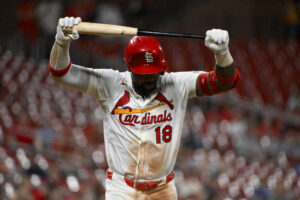Not long ago, the Reds found themselves in possession of what looked to be a borderline surplus of infielders. Elly De La Cruz, Matt McLain, Jonathan India, Noelvi Marte, Spencer Steer and Christian Encarnacion-Strand all had varying levels big league experience even before Cincinnati signed Jeimer Candelario to a three-year contract. A wide range of opinions on how to best divide the playing time persisted, but the Reds had the makings of a formidable collection of young bats.
Fast forward a few years, and none of that has really panned out. As MLBTR's Anthony Franco explored last month, that group has turned over a fair bit. Marte now patrols the outfield more than the infield. India is in Kansas City, traded last winter in exchange for right-hander Brady Singer. Candelario was released halfway through what has turned out to be a significant misstep of a signing. Encarnacion-Strand has been beset by injury. Steer has bounced all around the diamond, including in the outfield, but he's settled in more at first base. De La Cruz is entrenched at shortstop. McLain, who's struggled in the wake of 2024 shoulder surgery, remains an ongoing question mark. Top prospect Sal Stewart was recently promoted to the majors for his first look, giving them yet another high-upside infield piece to consider.
Even with that prior glut of infielders, the Reds felt compelled to trade for Ke'Bryan Hayes at this year's deadline and infielder/outfielder Gavin Lux last offseason. The overall offense in Cincinnati has been tepid, at best. The Reds, despite playing in perhaps the most homer-friendly park in the sport, rank 23rd in MLB with 146 home runs. They're 13th in runs scored, 16th in batting average and on-base percentage, and 21st in slugging percentage. The offense is ... fine. It's not a glaring deficiency, but it's also not going to turn any heads.
On the other side of the game, however, the Reds have enjoyed a more significant boom. Cincinnati's pitching staff is virtually teeming with enticing young options. Even with Nick Martinez and deadline pickup Zack Littell slated to become free agents, the Reds are deep in rotation arms. The aforementioned Singer is the priciest of the bunch heading into 2026, as he'll be due a raise on his $8.75MM salary, presumably pushing him past $12MM. The rest of the group is generally affordable, if not making at or very near the league minimum.
It's a fine line to walk, of course, as any "surplus" in baseball can dry out in a hurry, but this version of the Reds seems well positioned to flip some of that pitching talent in exchange for some offensive firepower when the offseason rolls around.

Unlock Subscriber-Exclusive Articles Like This One With a Trade Rumors Front Office Subscription
- Access weekly subscriber-only articles by Tim Dierkes, Steve Adams, and Anthony Franco.
- Join exclusive weekly live chats with Anthony.
- Remove ads and support our writers.
- Access GM-caliber tools like our MLB Contract Tracker

